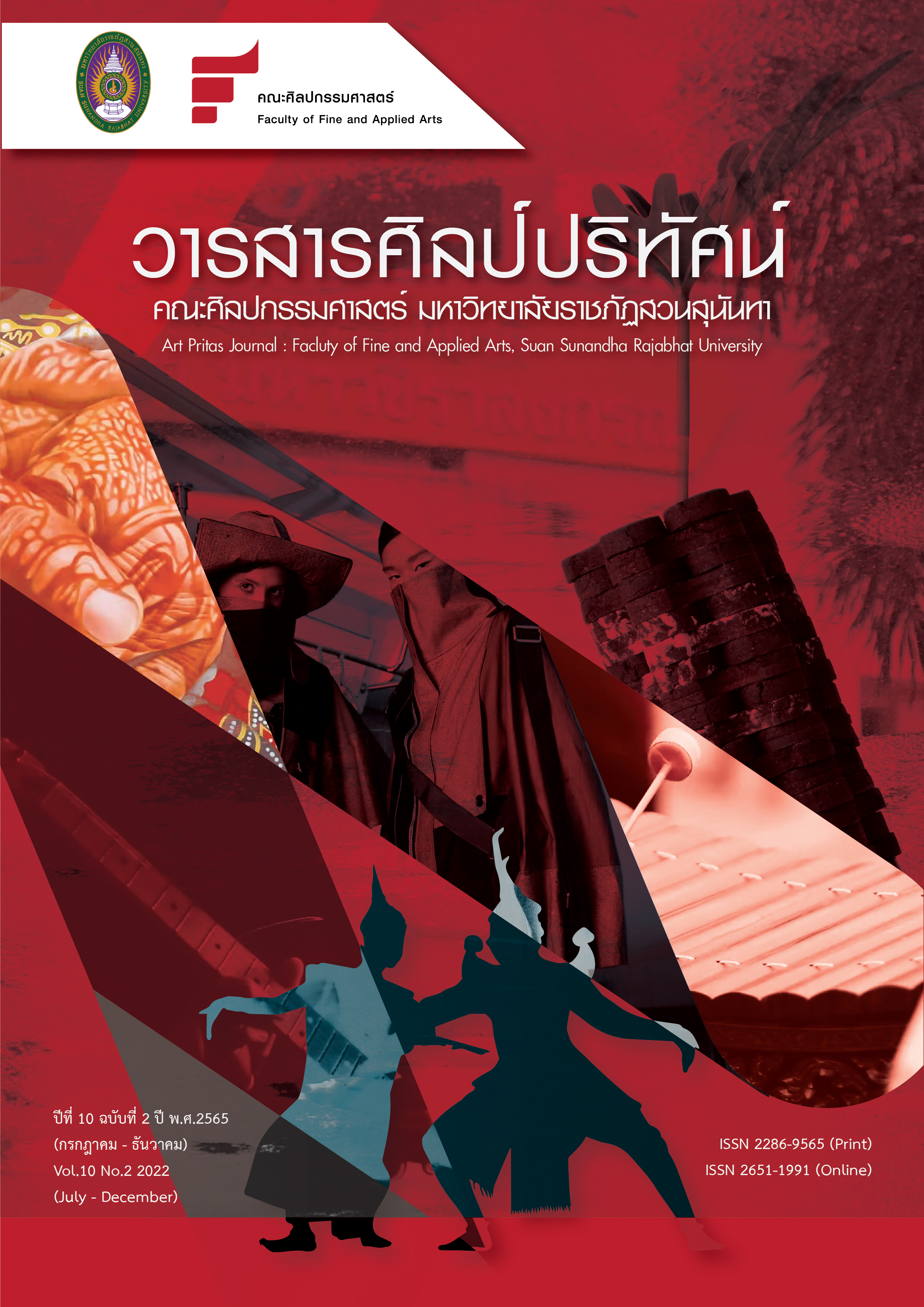การศึกษาและรวบรวมองค์ความรู้ภูมิปัญญาด้านศิลปหัตถกรรมของจังหวัดเชียงใหม่ เพื่อการสร้างสรรค์การแสดง
Main Article Content
บทคัดย่อ
การวิจัยนี้ มีวัตถุประสงค์เพื่อศึกษา และรวบรวมองค์ความรู้ภูมิปัญญาด้านศิลปหัตถกรรมของจังหวัดเชียงใหม่ โดยใช้ระเบียบวิธีการวิจัยเชิงคุณภาพ ในการเก็บรวบรวมข้อมูลจากเอกสารทางวิชาการ การสังเกตการณ์ การสัมภาษณ์ สื่อสารสนเทศ นำมาวิเคราะห์ และสังเคราะห์จนเกิดองค์ความรู้ที่สามารถนำไปเป็นแนวทางในการสร้างสรรค์การแสดง
ผลการวิจัยพบว่า ศิลปหัตถกรรมจังหวัดเชียงใหม่ สามารถจำแนกตามวัสดุ และกระบวนการผลิตได้เป็น 6 กลุ่ม ได้แก่ 1) หัตถกรรมผ้าทอ 2) หัตถกรรมไม้แกะสลัก 3) หัตกรรมเครื่องจักสาน 4) หัตถกรรมเครื่องปั้นดินเผา 5) หัตถกรรมเครื่องเงินและโลหะ และ 6) หัตถกรรมกระดาษสา งานหัตถกรรมนี้สามารถเป็นแนวทางสู่การสร้างสรรค์การแสดง ซึ่งปัจจุบันมีการแสดงเชิงหัตถกรรมที่ได้นำเสนอ 2 รูปแบบ คือ การแสดงที่ใช้หัตถกรรมเป็นส่วนประกอบการแสดง และการแสดงที่แสดงถึงกระบวนการขั้นตอนการผลิตหัตถกรรม การสร้างสรรค์การแสดงต้องมีวิธีการดำเนินงานอย่างเป็นขั้นตอน ผู้วิจัยแบ่งออกเป็น 3 ขั้นตอน คือ 1) การศึกษาข้อมูล 2) การออกแบบองค์ประกอบการแสดง และ 3) การฝึกซ้อมการจัดการแสดง โดยเริ่มจากการศึกษาประวัติความเป็นมา กระบวนการขั้นตอนการผลิต เพื่อออกแบบท่ารำ ท่าเต้น เครื่องแต่งกาย เพลง ดนตรี และอุปกรณ์การแสดง ตามหลักทฤษฎีนาฏยลักษณ์ ที่ต้องสอดคล้องกับบริบททางศิลปวัฒนธรรมของสังคมที่ศึกษา รวมทั้งการคัดเลือกนักแสดงการฝึกซ้อมให้เกิดความชำนาญสู่การจัดการแสดงต่อสาธารณชนที่เกิดเป็นองค์ความรู้ใหม่ อีกทั้งเป็นการอนุรักษ์ และเผยแพร่องค์ความรู้ภูมิปัญญาด้านศิลปหัตถกรรม พัฒนาไปสู่การส่งเสริม ประชาสัมพันธ์การท่องเที่ยวเชิงวัฒนธรรมตามแหล่งชุมชน และผู้วิจัยเห็นว่ายังมีองค์ความรู้ภูมิปัญญาด้านศิลปหัตถกรรมอื่น ๆ ที่น่าสนใจในการสร้างสรรค์การแสดงอีกหลายอย่าง ผู้วิจัยหวังว่าบทความนี้สามารถสร้างแรงบันดาลใจ และเป็นแนวทางให้กับผู้ที่สนใจในการสร้างสรรค์การแสดงเชิงศิลปหัตถกรรมที่ส่งเสริมภูมิปัญญาด้านศิลปหัตถกรรมของแหล่งชุมชนพื้นที่ต่าง ๆ ทั้งในเชิงธุรกิจ และเชิงวิชาการต่อไป
Article Details

อนุญาตภายใต้เงื่อนไข Creative Commons Attribution-NonCommercial-NoDerivatives 4.0 International License.
เนื้อหาและข้อมูลในบทความที่ลงตีพิมพ์ในวารสารศิลป์ปริทัศน์ ถือเป็นข้อคิดเห็นและความรับผิดชอบของผู้เขียนบทความโดยตรง ซึ่งกองบรรณาธิการวารสารไม่จำเป็นต้องเห็นด้วย หรือร่วมรับผิดชอบใดๆ
บทความ ข้อมูล เนื้อหา รูปภาพ ฯลฯ ที่ได้รับการตีพิมพ์ในวารสารศิลป์ปริทัศน์ถือเป็นลิขสิทธิ์ของวารสารศิลป์ปริทัศน์
เอกสารอ้างอิง
กัญญาณัฐ แสงทองสุข และคณะ. (2561). ฟ้อนโคมบูชา หัตถศิลป์ ถิ่นเมืองสาตร. (นาฏนิพนธ์ปริญญาบัณฑิต). มหาวิทยาลัยราชภัฏเชียงใหม่.
กนกพร โพธิเรือง และคณะ. (2561). เกิกเกว้า วัฒนธรรมเผ่ากะเหรี่ยง. (นาฏนิพนธ์ปริญญาบัณฑิต). มหาวิทยาลัยราชภัฏเชียงใหม่.
กนกเรขา ทาทอง และคณะ. (2563). ปี๋ใหม่เมือง. (นาฏนิพนธ์ปริญญาบัณฑิต). มหาวิทยาลัยราชภัฏเชียงใหม่.
กลุ่มงานยุทธศาสตร์และข้อมูลเพื่อการพัฒนาจังหวัด. (2560). บรรยายสรุปจังหวัดเชียงใหม่ : ข้อมูลทั่วไปของจังหวัดเชียงใหม่. เชียงใหม่: สำนักงานจังหวัดเชียงใหม่.
กุลณัฐ ขวัญอยู่ และคณะ. (2563). จุลกฐินถิ่นแม่แจ่ม. (นาฏนิพนธ์ปริญญาบัณฑิต). มหาวิทยาลัยราชภัฏเชียงใหม่.
คะนึงนิจ สมพงษ์ และคณะ. (2548). ฟ้อนหัตถาศิลาดล. (นาฏนิพนธ์ปริญญาบัณฑิต). มหาวิทยาลัยราชภัฏเชียงใหม่.
ธงชัย จีนชาติ และคณะ. (2563). นารีศรีชาติพันธุ์. (นาฏนิพนธ์ปริญญาบัณฑิต). วิทยาลัยนาฏศิลปเชียงใหม่.
เนาวรัตน์ ฐิติชาญชัยกุล. (2555). ภูมิปัญญาศิลปหัตถกรรมการแกะสลักไม้: กรณีศึกษาสหกรณ์หัตถกรรมผลิตภัณฑ์ไม้สันป่าตอง อำเภอสันป่าตอง จังหวัดเชียงใหม่. (วิทยานิพนธ์ปริญญามหาบัณฑิต). มหาวิทยาลัยศรีนครินวิโรฒ.
ปิยะนุช แสนกันและคณะ. (2554). จักรลายไม้ถวายลายศิลป์. (นาฏนิพนธ์ปริญญาบัณฑิต). มหาวิทยาลัยราชภัฏเชียงใหม่.
ไพโรจน์ วงศ์วุฒิวัตน์. (บ.ก.). (2532). ความเป็นมาของงานศิลปหัตถกรรมไทย. กรุงเทพฯ: ธนาคารกรุงเทพ.
วิบูล ลี้สุวรรณ. (2539). ศิลปหัตถกรรมพื้นบ้าน. กรุงเทพฯ: ปานยา.
สุรพล วิรุฬห์รักษ์. (2547). หลักการแสดงนาฏยศิลป์ปริทรรศ์. กรุงเทพฯ: สำนักพิมพ์จุฬาลงกรณ์มหาวิทยาลัย.
อานนท์ อาภาภิรม. (2525). สังคม วัฒนธรรม และประเพณีไทย (พิมพ์ครั้งที่ 2). กรุงเทพฯ: โอเดียนสโตร์.
อุดมศักดิ์ อินทะมาตย์ และคณะ. (2556). ฟ้อนหัตศิลป์ถิ่นสันกำแพง. (นาฏนิพนธ์ปริญญาบัณฑิต). มหาวิทยาลัยราชภัฏเชียงใหม่.


